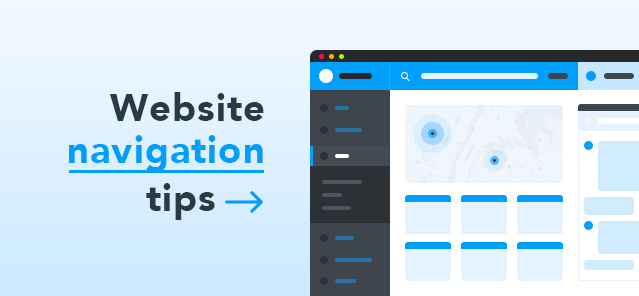
14 Sep How to Improve Your Website Navigation?
These website navigation best practices will guarantee that your website offers an effective method for visitors and search engines to locate the information they are looking for.
When done correctly, website navigation is beneficial to both your visitors and your search engine optimization effectiveness.
A well-designed website navigation system makes it simple for your visitors to discover what they are looking for, as well as for search engines to scan your site. As a consequence, more conversions are occurring, and search exposure is increasing.
But, more importantly, how do you go about doing it? By following these best practices for website navigation.
What Is Website Navigation?
Website navigation (also known as internal link architecture) refers to the links that run across your website and connect its pages. The main goal of website navigation is to assist visitors in quickly locating information on your website.
To find and index new pages on your website, search engines utilize the navigation on your website. In addition to assisting search engines in understanding the destination page’s content and context, also links aid in understanding the connections between sites.
First and first, users are prioritized. This is the overarching goal of website navigation, and you must keep it in mind at all times.
First and first, users must be satisfied. So make navigation as simple as possible. Then, optimize for search engines without detracting from the user experience as much as possible.
The following SEJ articles may be of use if you need more fundamental knowledge on website navigation:
Internal Link Structure (internal link structure) Corey Morris writes about SEO best practices to help you improve your rankings.
This article by Julia McCoy is titled “Your Essential Guide to Internal Content Linking.”
With a broader emphasis on website navigation best practices, the rest of this article will outline different internal linking scenarios that may create problems for your website users and search engines.
If you operate on a big website, this subject will be very relevant and essential to you.
Methods for Increasing the Usability of Your Website’s Navigation
Almost every website includes some navigation to help users get around. Unfortunately, not every website has a user-friendly navigation system. The majority of the time, the navigation of a website is created by Web designers who are very knowledgeable about building visually appealing websites but have little knowledge about marketing a website or developing a website tailored to the client’s needs.
Having built-in navigation does not imply that it performs the most fabulous job of providing visitors with what they are looking for.
Your website’s entire performance may be made or broken by the navigation system responsible for retaining visitors, keeping them interested, and guiding them through the conversion funnel.
A well-designed website’s navigation makes it simple for users to locate the content that interests them without having to go on a potentially tedious “search.” Additionally, it assists search engines in quickly and effectively indexing your actual content.
Poor navigation, on the other hand, does more damage than benefit. It causes people to get perplexed and sends them running for the exit. When they are unable to locate what they are searching for, you cannot get the conversion you want.
How To Improve Your Website Navigations
Maintain a consistent approach. In addition to making your site easier to use, consistent navigation — both in terms of how and where it appears on your site – improves your visitors’ ability to locate important content more quickly. If your navigation changes from page to page regularly (unless in the most extreme cases), visitors will lose their bearings on your site and will need to reposition themselves frequently.
- Make clear divisions between categories. The classes in your navigation must be clearly and aesthetically defined whether your navigation includes numerous sections, categories, or sub-categories. This means that category headers and sub-categories must be visually distinguished from one another, even if the classes themselves are hyperlinks.
- Make all navigation items clickable links by using hyperlinks. For example, every header element in your navigation should be a clickable link when you have numerous category divisions in your navigation. This is true even when using drop-down menus when selecting a sub-category link may be the visitor’s natural tendency.
- Make use of precise navigation titles. Before they click on a navigational link, visitors should have a rough sense of what they should expect to discover on a specific page. This holds actual whether the connection is part of the main navigation or an internal text link. Use correct language to describe the linked page to know what they will be receiving. Visitors are confused and irritated when they see cryptic or deceptive navigation language, leading to site abandonment. Always check that any link wording, whether in text or an image, appropriately depicts the sites to which it points.
- Make sure that every clicked picture includes an ALT text description. This is true for any photo, but it is especially true for images that include hyperlinks to other sites. When writing descriptive language, be sure to add the ALT property. Using this method, you can guarantee that everyone understands the link, regardless of how they are accessing your site.
- Check to see that your search function is operational. When utilizing an in-site search function, the search results page must always provide relevant results to the search query entered. It is required to correct for misspellings, present comparable goods, and even generate results for products that you do not currently sell while showing similar products that you do sell. Never display a search result with the words “no items found.”
Until You Can Demonstrate That It Works, It Is Not Effective.
A simple and efficient method to evaluate your website’s navigation is first to visit the website of a rival. Throughout the process, make notes on what you like and dislike. In addition, make a note of any difficulties you encounter, as well as anything that jumps out as particularly noteworthy. Then return to your site and repeat the navigation and note-taking procedures as you did before.
Compare your notes across the two sites and see if you can do to improve your navigation. I am confident that you will discover places where your navigation is better, but you will also likely find areas where your navigation is worse.
Of course, using your statistics to observe how people are moving around your site is a much superior method of testing. Make modifications just as soon as you can evaluate them using A/B or multivariate testing to guarantee that you can make changes that will benefit rather than hinder the overall performance of your website. Make use of any resources you have available to you. Continue to test and modify your website to ensure that your visitors have the most excellent possible experience and that you are receiving the results you want.



Sorry, the comment form is closed at this time.